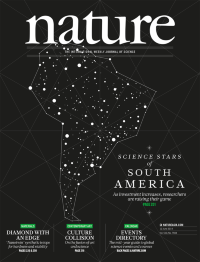Volume 510
-
No. 7506 26 June 2014
Aspergillus versicolor fungus conidiophore and spores, stained with pactophenol cotton blue. Infection with Gram-negative pathogens bearing metallo-β-lactamases such as NDM-1 and VIM is a growing public health problem and threatens the use of penicillin, cephalosporin and carbapenem antibiotics to treat infections. Here, Gerard Wright and colleagues report a screen for naturally produced inhibitors of NDM-1 in an extensive collection of DMSO-dissolved natural product extracts derived from environmental microorganisms. One extract (from A. versicolor) exhibited a particularly potent anti-NDM-1 activity and was identified as aspergillomarasmine A (AMA), a natural product first reported some 50 years ago associated with leaf wilting. AMA is a rapid and potent inhibitor of both NDM-1 and VIM-2, and the authors find that AMA fully restores antibiotic efficacy in vitro and in vivo against bacterial pathogens possessing either VIM- or NDM-type resistance genes. AMA is non-toxic and well tolerated, making it a realistic prospect as an antibiotic adjuvant. Cover: Dennis Kunkel Microscopy, Inc./Visuals Unlimited/Corbis.
Nature Outlook
-
No. 7505 19 June 2014
Water droplets cooling rapidly in vacuum are probed by an intense pulse from a femtosecond X-ray laser before they turn to ice, providing Jonas Sellberg et al. with unique structural information on the deeply supercooled liquid phase in the so-called no-mans land, where waters anomalous properties become strongly enhanced, but where ice forms too quickly for normal measurement techniques to cope. In a second paper Jeremy Palmer et al. explore water in this regime with advanced simulation methods, finding a phase transition between two structurally distinct liquids that could explain many water anomalies. Cover: Gregory Steward, SLAC National Accelerator Laboratory.
-
No. 7504 12 June 2014
Media attention will be focused on Brazil and its South American neighbours for sporting reasons over the next few weeks. But with science in mind Natures special issue kicks off with a graphic tour of South and Central America that details the inputs and outputs of research and development there. We profile key institutions and research groups, and report on a programme that sends some of the regions finest researchers to gain experience in North American labs, and on efforts to repatriate scientists who have already made their names abroad. Finally, we canvass opinions on how science can help towards achieving the goal of sustainable economic growth in the region. (Cover: Jasiek Krzysztofiak/Nature)
-
No. 7503 5 June 2014
Many of the high-resolution membrane protein structures published recently are notable for the presence of lipids closely associated with the protein, prompting the question, how are these lipids influencing membrane complex structure? Carol Robinson and colleagues have developed a new ion mobility mass spectrometry (IM-MS) method that enabled them to obtain mass spectra of folded protein conformations bound to lipids. Using this method they identified lipids that altered the stability of MscL (mechanosensitive channel of large conductance), aquaporin Z and the ammonia channel. They then determined the X-ray crystal structure of the ammonia channel bound to one of these lipids (phosphatidylglycerol), which revealed how a conformational change in a specific loop led to the formation of a phosphatidylglycerol-binding site. The major conclusion from this work is that an individual lipid-binding event can change the stability of a membrane complex. On the cover, IM-MS captures a native membrane protein complex emerging from an ion mobility cell. Shown is the ammonia channel in apo, one- and two-lipid bound states. Cover: Arthur Laganowsky
Insight




